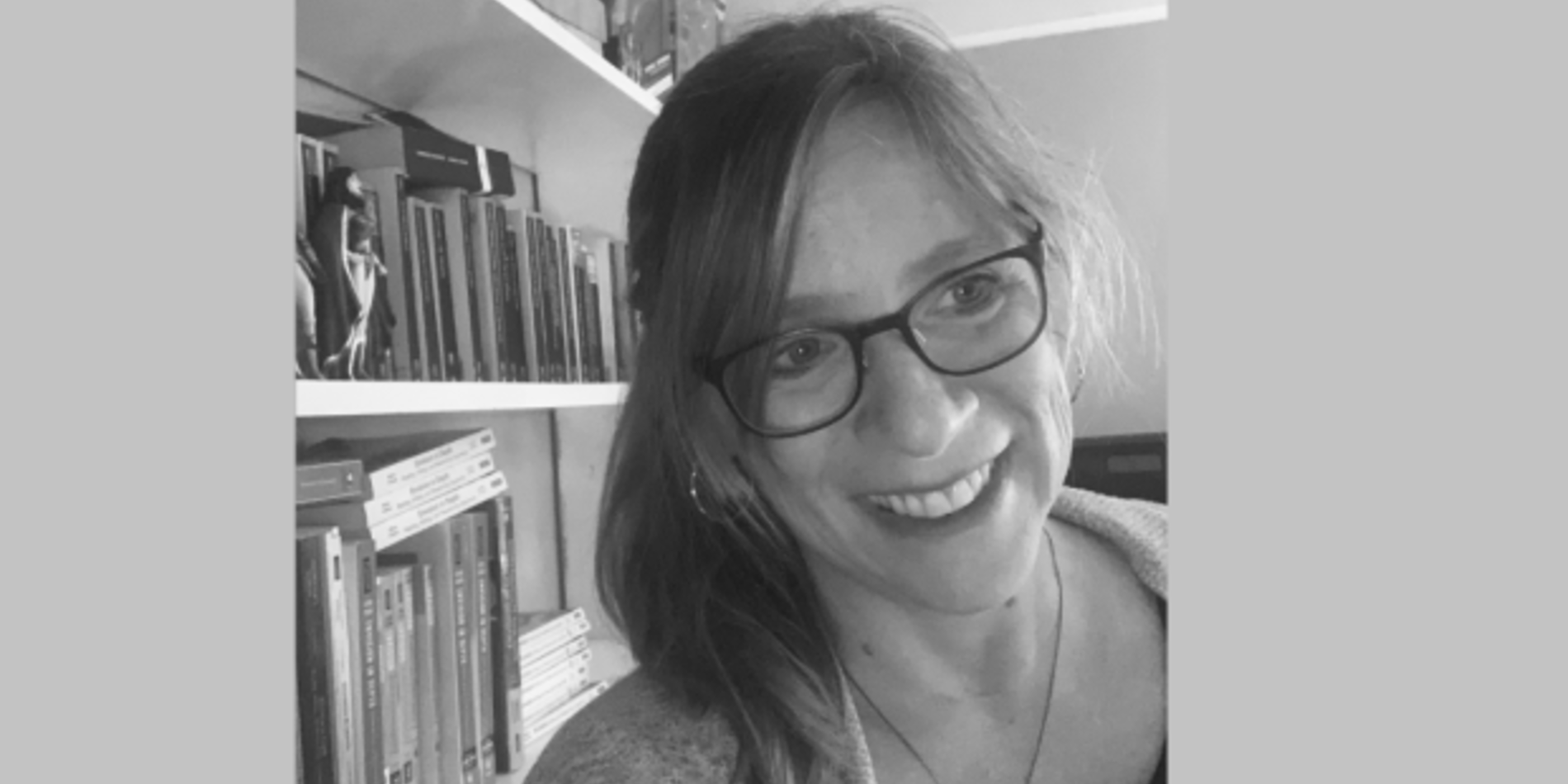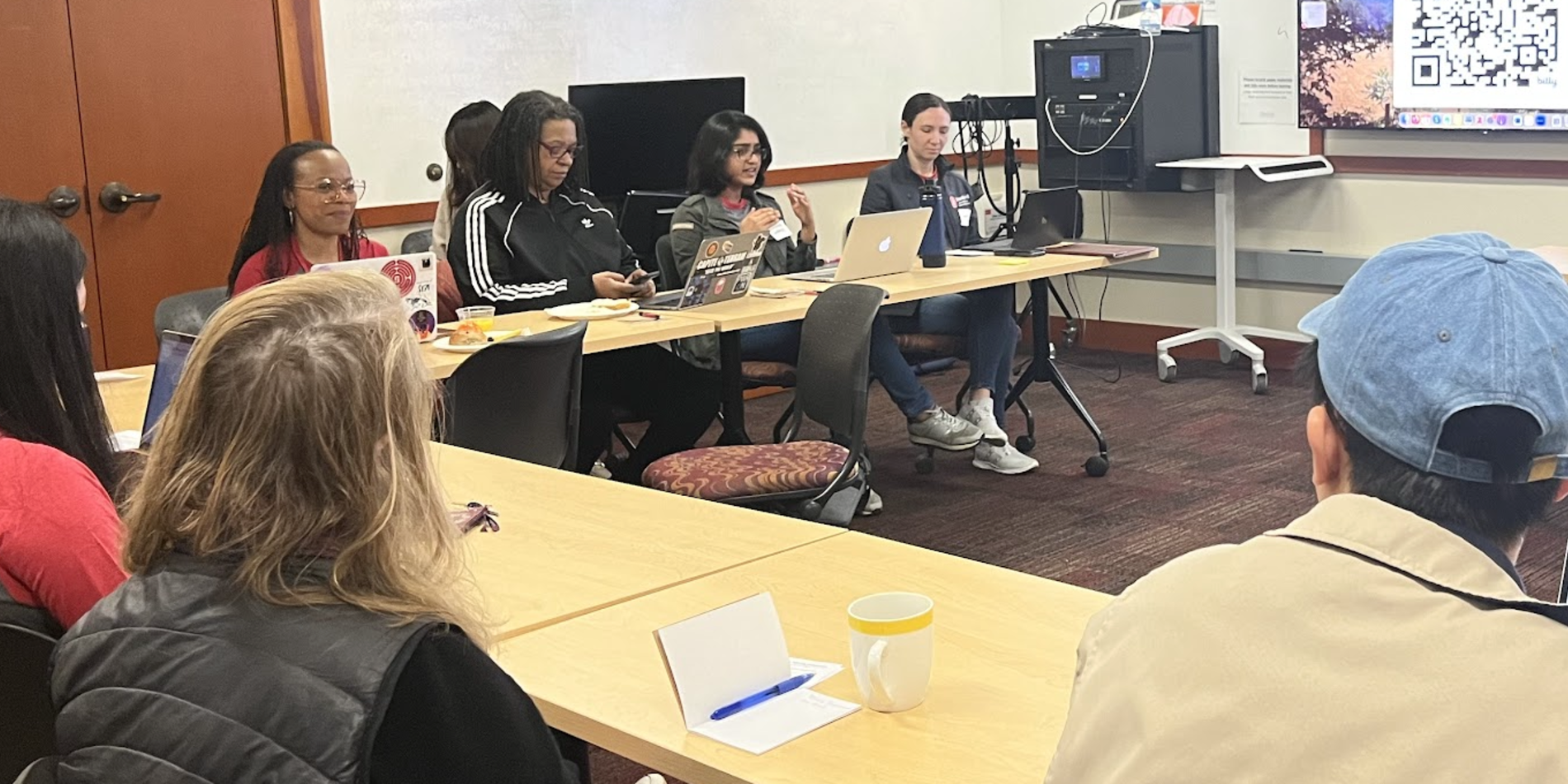Zoomspirations: Inspiring Moments from Teaching Spring Online
Pictured above: Dr. John P. A. Ioannidis (left) visiting with Kevin Moore (top), Mutallip Anwar (not pictured) and students from two spring PWR 1 classes
Spring was hardly a normal quarter for PWR instructors and students alike. However, despite the unusual circumstances, our colleagues created meaningful, powerful experiences for their classes. Read below to be inspired by some of the innovative teaching that took place in the PWR Zoomiverse last spring.
Featured Zoomspiration: Mutallip and Kevin
Since the outbreak of the coronavirus, many instructors have felt a special urgency to help students process the fraught public discourse surrounding the pandemic, as well as the emerging scientific research on the virus itself. Because of the urgency of the situation, as it has been widely observed, much of this research is transpiring outside traditional channels of peer review: in editorials and press releases, on pre-print servers such as Medrxiv and Biorxiv, and on “scientific Twitter.” The conventions and pathways of bioscientific publication are rapidly evolving.
In Spring Quarter, Mutallip Anwar and Kevin Moore decided to give students more than a passing glimpse into this shifting research landscape, including its controversies. Curating a few readings from the conversation as examples for the TiC unit of their respective PWR 1 courses (“The Power of Words: The Rhetoric of Social Change” and “Trust, Rhetoric, and Writing”), they invited students to weigh in on the emerging debates, including questions regarding the reliability and replicability of scientific research. Not surprisingly, the work of Stanford’s own John. P.A. Ioannidis became a cornerstone of the conversation. Ioannidis holds the C.F. Rehnborg Chair in Disease Prevention in Stanford’s School of Medicine, and he co-directs the Meta-research Innovation Center (METRICS). He is a legend of scientific rigor and one of the most widely cited scientists in the world. In recent years, he has also been a critic of “stealth research” that occurs outside the context of peer review (he is one of the original critics of the defunct biotech unicorn Theranos). Yet the scientist found himself caught in a political fray in March after he published an editorial in Stat questioning whether initial projections regarding the severity of the coronavirus might reflect not a “once-in-a-century pandemic,” but a “once-in-a-century evidence fiasco.” The article was widely misrepresented by conservative pundits and media as justification for immediately reopening the economy, when Ioannidis was merely pointing out the lack of reliable data and the potential dangers of long-term shutdowns. Although many of his predictions have proved correct, the polarized conversation surrounding them illustrates an alarming “medical tribalism” that threatens the progress of biomedical research in our time.
In Dr. Moore’s class, a loose campaign emerged to ask the scientist if he might be willing to visit class via Zoom, to answer some questions firsthand. This felt like a long shot: as Dr. Moore put it, “Amid a pandemic, to ask one of the world’s leading epidemiologists to speak with a group of freshmen admittedly felt a little non-essential.” Yet in the spirit of pursuing direct action in research, the class decided to give it a shot, and together they crafted an email thanking the scientist for his work and asking if there was any chance he might be able join a brief Q&A.
Dr. Ioannidis replied in four minutes. In what Dr. Moore calls “the humblest email I have ever received from a senior academic,” the scientist said he’d be happy to join PWR students for a chat.
Three weeks later, Dr. Ioannidis joined a group of Dr. Anwar and Dr. Moore’s students for thirty minutes, offering an intellectual candor that was tangible even mediated by Zoom. In response to a question regarding how his work on the coronavirus has been sensationalized, Dr. Ioannidis reported that it is “amazingly bad” how science has become politicized in our time. He confided to students that he is an “introvert” who purposefully avoids social media and the public eye, but has lately found himself agreeing to appear on television and other venues because he and his colleagues’ findings about the virus are “not something that can be hidden under the carpet.” He is the first to address the limitations of the Santa Clara seroprevalence study widely cited in the media in April, where he was one of seventeen co-authors, and for that matter all emerging research because “no single study alone can be the end of the story in science.” Addressing the public criticism he received for having allowed himself to be interviewed on Fox News, and whatever that might imply about his politics, Dr. Ioannidis explained, laughing, “I appeared in Fox News in places where Tony Fauci had been the previous guest. I appeared in more CNN venues than Fox.”
When asked about what might help to improve science, he reported that better science could only be a “grassroots movement.” “If you consider the effort to improve research as extraneous to research,” he said, “then you lose everything.” Indeed, he confirmed, “black box” or “stealth” research, which makes use of proprietary or otherwise restricted data and methods, has become a big problem for science. Citing the earliest protocols of the Royal Society, he pointed out that repeated demonstration of a principle or fact has always been the core of the scientific method. Replication needs to be part of the process of research design “from the very beginning.” He recalled the example of Theranos, warning that black-box practices at highly-valued biotech firms remain a serious concern.
The visit, and the subsequent shared conversation between Dr. Anwar and Dr. Moore’s classes, was indeed one of the highlights of Spring Quarter for the students who attended—and one that underscores the potential of Zoom to facilitate encounters that might be more difficult to arrange in person.
Read on for more amazing Zoomspirations
Becky Richardson
One of the things I started missing this past spring was the impromptu conversations that you usually have as students come into the classroom -- the casual questions and anecdotes that end up creating that sense of fellow-feeling. As our Zoom-quarter progressed last spring, I was inspired by those moments that recreated some of that sense of shared experience and good humor. I was delighted when students started signing on earlier to chat a bit before class formally started, or when someone would bring our attention to their home-made haircut or hair color (we had some talented stylists!). Another highlight was whenever we watched a video together and the class used the "chat" function in Zoom to comment on whatever we were watching. For ex., when we had the wonderful pre-recorded OCT "presentation on presentations," my students were piping up to comment on the bad example slides -- from suggesting ways to make that shark slide work, to standing up for the pink triangle that may not serve much of a purpose, but somehow struck the class as charming in its purposelessness. It was a highlight for me to see students' sense of humor come through in moments like this!
Donna Hunter
I had one student who began the course as a very strong presenter (very rarely used filler words and spoke cogently and enthusiastically without notes) so I asked him to share some of the exercises he believed helped him become such a proficient speaker. One of the exercises was to have everyone give a 45 second-1 minute extemporaneous speech on a different silly topic (no repeats). Notable topics included: M&M’s vs. Skittles, boxers vs. briefs, Nickelodeon vs. Disney Channel, etc.
We did this exercise in breakout rooms and students didn't want to leave.They even posted follow-ups in the chat.
Hayden Kantor
I opened each class with an icebreaker in order to facilitate peer-to-peer exchanges over Zoom. Students were engaged right away because they each had to speak. The activities also provided a soft opening in case a student was a few minutes late logging on. Topics ranged from "how COVID-19 has changed your food practices" to sharing something unexpected that they learned in the research process. Later in the quarter, I polled them for topics that they wanted to learn about their peers. Examples included "favorite weird food combo" and "favorite study spot on campus." Students reported that they valued connecting with their peers and that these activities made class discussions less awkward because they felt like they were getting to know each other.
Holly Fulton
I invited my students to ‘play’ with elements of their online presence in the class (use those digital rhetorics!)...and they took it to the next level. They “upped their game” with emoji responses on Slack (I’m particularly partial to discoparrot and partycorgi), started playing with Zoom backgrounds (props to the campus images with Kermit photoshopped in), and deposited an assortment of high-quality memes to the class’ “anti-stress compendium” Slack channel (special recognition to the ‘time travelers in 2020’ memes). A side benefit: I had the perfect opening to Zoom-in from the deck of an Imperial Star Destroyer...
Tessa Brown
My Zoomspiration moment occurred outside of class time, on a Thursday and Friday night during the last full week of Spring quarter. For two years I had been meeting weekly with a group of undergraduates to create The Word: Tha Stanford Journal of Student Hiphop Research. We had always planned to create an online journal, but didn't expect all our spring meetings to be online--nor the launch party for our debut issue. On that Thursday, I logged onto Zoom and helped our outgoing editor welcome the three amazing scholars--Gwendolyn Pough, A.D. Carson, and Regina Bradley--for our panel on "Hiphop and Trap in the Academy." But it was the next night, Friday night, when we hosted a showcase of Stanford student hiphop artists, that I realized I didn't have the link to the behind-the-scenes Zoom, only the Youtube Live link like all the other guests. So I settled in on the couch, kicked up my feet, and watched my undergraduates steal the show. It was awesome.

Kathleen Tarr
There were a lot of terrific, Zoomspirational moments during Spring Quarter, but hands down the experience that Zoomspired us the most was when comedian Reggie Steele led a class workshop in stand-up, courtesy of artsCatalyst (and PWR’s class activity funding). Steele has been delivering workshops to my PWR 2 students for years, and we were concerned that the activity would be difficult to translate into virtual space, but it was awesome! The availability of breakout rooms meant Steele could confer with individual students about their writing process without distractions. We ended class with each student delivering their joke as if a comedy show. One student wrote that the workshop was “the highlight of my quarter so far by a mile!” Another shared what a great time he had and how refreshing the workshop was. It is a terrific reminder that when students feel fully engaged, “Zoom fatigue” isn’t a thing.
Sangeeta Mediratta
We did a round of topic speed-dating in a way that proved to be quite fun for all of us. Two students at a time were to ask each other a couple of assigned questions and a couple of spontaneous ones in an "interview" format lasting two minutes per student. I suggested that we all, other than the two participants, turn their videos off AND hide non-video participants while the interviewer and interviewee took the "stage." Students reported having fun with this activity and felt it was effective to have two people talking as if we were watching a YouTube video. Some students even planned ahead of time to think through their backgrounds so we felt we were on different "sets." The course theme is on objects and objectification so the visual rhetorics of the zoomscape were quite rich. Finally, students with videos-off posted questions for the students who were being interviewed in a google doc.
Yanshuo Zhang
I had a super effective "soft opening" to my spring PWR 1 Beauty Across Cultures class. Prior to the first day of the class, I asked students to bring a physical object that they think is beautiful and share a story or some thoughts about that object with their classmates and me on the first day. Many students brought objects with personal and sentimental values, from a pair of dance shoes their grandma gave them, to a painting that they made themselves, to a machine that they had built. This moment immediately brought students closer to each other and I could see them smile and nod. It was a humanizing and warm moment for a remote class. It also encouraged students to think about the course theme in more tangible and aesthetic, rather than simply theoretical and intellectual, ways.



